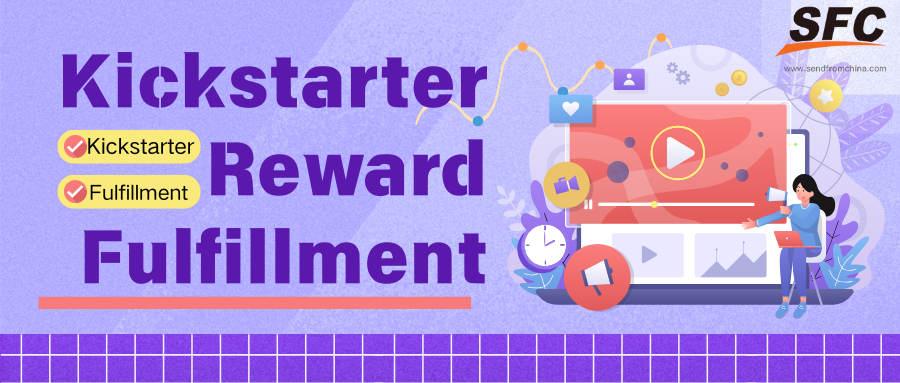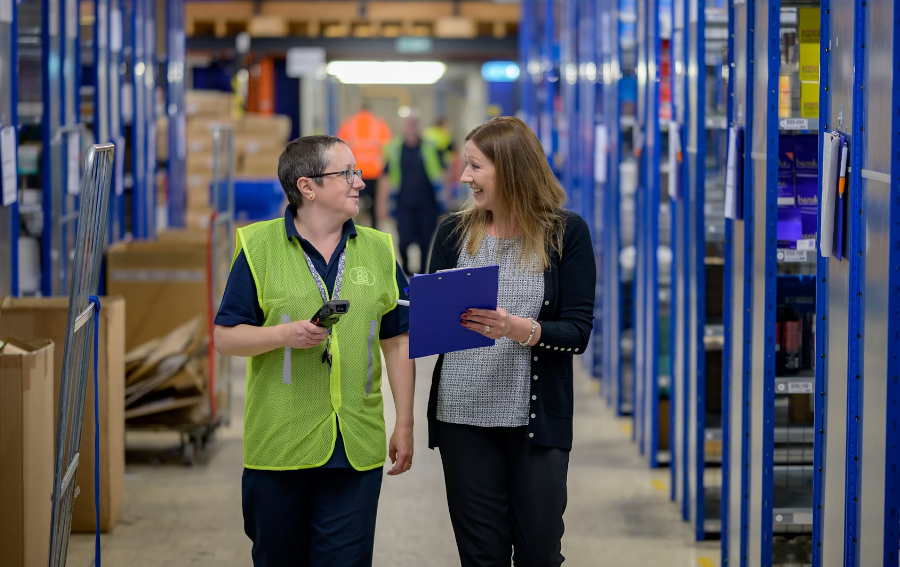Table of Contents
Get Custom eCommerce Fulfillment Service
Book a Meeting
Kickstarter Reward Fulfillment: The Complete Guide Before You Ship
Time: Oct 17,2025 Author: SFC Source: www.sendfromchina.com
When your Kickstarter campaign closes successfully, the “real work” begins. Fulfilling rewards is the moment of truth: it tests your logistics, your communication, and your promises to your backers. Done right, it builds trust and sets your venture up for long-term reputation. Done poorly, it can cause delays, negative reviews, and even damage to your brand.

In this guide, you’ll learn why fulfillment matters, how to plan early, how to execute in the post-campaign phase, how to avoid common pitfalls, and ultimately how SendFromChina (SFC) can partner with you to make the process smoother.
1. Why Fulfillment Matters for Kickstarter Reward
Kickstarter fulfillment isn’t a mere afterthought — it’s central to your project’s credibility. A study of Kickstarter projects revealed that 35% of backers never received rewards on time (or at all) when delivery dates were underestimated.
Backers don’t just invest money; they invest trust. If you miss delivery, or deliver with unanticipated costs (customs, damage, etc.), you risk negative press, delays, refund demands, or worse: losing your ability to run future campaigns.
2. Before You Hit “Launch” — Early Fulfillment Planning
Fulfillment isn’t something to think about only after your project funds. You should begin planning before your campaign even goes live. Here are essential preparatory steps:

Benchmark and forecast demand
Look at comparable campaigns in your niche. How many backers did they attract? What reward tiers were most popular? Use that to estimate your expected order volume (and a margin buffer).
Also factor in stretch goals, add-ons, late pledges — these can inflate total volume beyond your initial target.
Sketch your logistics chain
Map out how your product will move: factory → inland transport → port/airport → international freight → destination warehouses or fulfillment centers → local courier final mile. At each stage, ask: who handles it? Who pays? What paperwork is needed?
Budget shipping, customs, and overhead (with cushion)
From day one, include realistic shipping costs in your campaign goal. Determine volumetric (dimensional) weight vs actual weight. Calculate packaging materials (boxes, padding, labels), handling, storage, insurance, and customs duties. Many creators overlook hidden fees: fuel surcharges, remote area surcharges, remote sorting, or storage beyond free-wait days.
Also know local (e.g. Chinese) holiday periods — e.g. factory closures during Chinese New Year — to avoid blind spots in the schedule.
Keep reward tiers manageable
Simplify your product SKUs (variations). Fewer styles, fewer colors, fewer optional extras means fewer packing mistakes, less sorting complexity, and lower handling cost.
Also, avoid making major structural changes mid-campaign unless absolutely necessary — it complicates fulfillment routing downstream.
Choose your fulfillment strategy: hybrid, in-house, or 3PL
You have three main options:
In-house / self-fulfillment: You receive inventory, pack, label, ship all by yourself or a small team. Good for low volume (say, under a few hundred orders). But this demands warehouse space, shipping contracts, operations experience, staff, and time.
Hybrid / regional partners: You may handle shipping for one region (e.g. U.S. domestic) yourself, and outsource international fulfillment to specialized 3PLs.
Full 3PL / crowdfunding-specialist fulfillment: Outsource all warehousing, pick-pack, shipping, tracking, and customs support. This is the most scalable but demands careful vetting.
When evaluating 3PLs, prioritize:
Global/international shipping expertise
Customs clearance experience
Warehouse locations close to backer clusters
Order management systems integrated with pledge survey tools
Clear pricing (no hidden surcharges)
Policies for lost/damaged shipments & returns
Experience in crowdfunding / Kickstarter specifically
Decide when to collect addresses & ship charges
Do you collect backer shipping addresses immediately after funding? Or later, closer to fulfillment? Many campaigns use a pledge manager (e.g., BackerKit, PledgeBox) to handle surveys, upsells, and address verification.
One tradeoff: collecting too early invites address changes over time; collecting late may reduce your margin visibility for bulk freight planning.
Protect with backup plans
Inventory delays, customs freezes, shipping disruptions (e.g. port strikes), or pandemics can happen. Plan buffer stock, alternative freight modes (air vs sea), alternate 3PLs or splitting shipments. Having a contingency gives breathing room in crises.
3. Post-Campaign Phase: From Survey to Shipping
Once your campaign succeeds, the clock is ticking. Backers expect updates and progress. This phase is the execution window. Here's your roadmap.

Address collection and data cleanup
Send backer survey
Push your pledge manager or survey tool quickly to collect addresses, preferences, add-ons, and corrections.Send reminders & data verification
Follow up several times. Encourage completion.Clean the data
Normalize country, region, postal codes
Flag missing or invalid entriesNormalize country, region, postal codes
Contact backers with missing pieces
Cross-check duplicates or changes
Some backers may have moved or made mistakes — expect up to 5–10% needing follow-up.
Inventory receipt and QC at fulfillment center
Once your manufacturer ships inventory to your 3PL or China warehouse:
Inspect upon arrival
Run count/weight/quantity audits
Spot-check units for defects
Segregate defective items
Run test shipments to ensure packaging integrity
Only after inventory is confirmed should you begin pick-pack workflows.
Order batching, kitting & pick-and-pack
Segment orders by destination region
Consolidate kits (if a reward requires multiple SKUs)
Apply packing rules (oversize, fragile, weight thresholds)
Use zone-based optimization to reduce transit cost
Generate labels and tracking numbers
Include inserts, thank-you cards, or extras
Customs, documentation & shipping
For each destination, ensure correct HS codes, customs declarations, invoice values
Determine whether you (or the 3PL) pay duties or whether customers will pay on delivery
Use bonded or free-trade zones if applicable
Choose shipping methods (air, sea, express, postal) based on cost vs timeline
For the EU, IOSS registration helps simplify VAT collection
Track shipments and monitor delivery status
Customer communication & tracking
Send backers their tracking numbers and estimated time
Provide updates on delays or customs hold-ups
Build a small helpdesk or FAQ page for shipping issues
Prepare compensation or reship policies
Handling exceptions, returns & replacements
Monitor non-delivered items or returns
For items lost in transit, arrange reship
For damaged arrivals, accept returns or send replacements
Keep inventory of spare units
Log and analyze exception reasons to prevent recurrence
Post-fulfillment wrap-up & data archiving
Close out the campaign’s fulfillment accounting
Archive order and inventory logs
Solicit feedback or testimonials from backers
Assess lessons learned for your next campaign
If you intend to move into e-commerce, transition to ongoing fulfillment model
4. Common Pitfalls & How to Avoid Them
When it comes to executing a crowdfunding campaign, the fulfillment phase is where many promising projects stumble—or even fail. Below is an expanded list of pitfalls that many creators underestimate, along with practical mitigation strategies grounded in real-world experience and industry best practices.

Underestimating Shipping & Logistics Costs
Creators often model shipping rates based on ideal or simplified assumptions: flat weights, best-case zones, no customs duties or surcharges. But real logistics costs are complex—dimensional weight, surcharges (fuel, remote area, handling), packaging materials, customs clearance, and postal or courier markups add up quickly. Even within a single country (e.g. U.S.), zone surcharges and peak-season inflation push costs much higher than simple estimates.
Mitigation strategies
Get real quotes early: Request sample quotes from multiple couriers (e.g. FedEx, DHL, postal, regional carriers) using your estimated package dimensions and zones.
Model worst-case scenarios: For each tier, run cost projections with +20–30 % buffers.
Use volumetric (dimensional) weight modeling: Always assume your packaging adds bulk; use volumetric formulas rather than just “actual weight.”
Negotiate with carriers and aggregators: As volume increases, you can secure discounted rates or favorable terms.
Segment shipping by zone: For distant or high-cost regions, consider charging a supplemental shipping fee (if your campaign structure allows) or using cheaper slower methods to those zones.
Overpromising & Under-Delivering on Timelines
In a competitive crowdfunding environment, creators often compress timelines to appeal to backers—“deliver in 3 months!” However, delays in manufacturing, sourcing, tooling, regulatory testing, or customs are quite common. When reality diverges from optimistic schedules, disappointment or worse (loss of trust) follows.
Mitigation strategies
Add ample buffer time: In your timeline, include at least 20–30% more time than your “ideal” plan to absorb unplanned delays.
Lock major dates post-confirmation: Avoid announcing shipment dates until you’ve confirmed tooling, supplier readiness, logistics partner availability.
Communicate proactively: If a delay is inevitable, inform backers early, explain the cause, and present a revised timeline. Backers generally appreciate transparency over surprises.
Stage or batch shipments: Rather than a single massive send, break deliveries into waves (e.g. region by region) so that delays in one area don’t hold up all shipments.
Failing to Plan for Scale / “What if it goes viral?”
Many campaigners anticipate modest demand, but if a campaign suddenly spikes (media pickup, influencer share), volume multiplies. At such scale, operations that function at 100 units may collapse at 10,000 units.
Mitigation strategies
Design systems with headroom: Use fulfillment partners who can scale, or ensure your internal processes have buffers (staff, space).
Limit SKU complexity: Reduce variants, colors, add-ons—each variation increases complexity in picking, packing, and inventory management.
Use automation & tooling: Employ software, barcode scanning, batch printing, order management, and integrations to reduce manual errors under load.
Set realistic stretch goals: If you anticipate large demand, build fulfillment cost scaling into your stretch goal planning—don’t let sudden demand bankrupt your logistics plan.
Poor Inventory & Warehouse Management
Miscounts, lost units, misplacements, and oversights in warehouse organization are common when speed and volume increase. Without reliable inventory systems, stockouts or overstock can emerge.
Mitigation strategies
Cycle counts and audits: Periodically verify physical inventory against system records, especially before shipping waves.
Zone inventory by region: If your fulfillment partner has multiple hubs, preposition inventory closer to high-volume markets.
Organize warehouse layout smartly: High-move SKUs should sit closer to packing stations; group items used together in kits.
Use barcode or RFID scanning: Automate pick/pack verification to reduce human error.
Keep reserve/spare inventory: Hold extra units (5–10 % margin) for replacements, defects, or unexpected overages.
Inadequate Quality Control & Testing
Under schedule pressure, testing and inspection are often rushed or skipped. As a result, faulty parts, missing components, or substandard packaging slip through. By the time your backers receive poor-quality goods, reputational damage is done.
Mitigation strategies
Multi-stage QC: Implement checks at prototype, during production run, pre-shipment, and post-arrival at warehouse.
Test under stress: Simulate drop tests, vibration, extreme temperatures that mimic real transit conditions.
Check full units, not just random parts: Especially for kits or multi-part rewards, test assembly and full operation.
Reject and rework policy: Don’t ship defective units—set up re-inspection or rework buffer time.
Log defects and root causes: Track defect rates by type, analyze causes, feed insights back into production.
Customs, Duties & Regulatory Issues
Cross-border shipping invites complications: mis-declared goods, incorrect HS codes, undervaluing, or failure to collect required VAT. These errors lead to cargo being held at customs, fines, or unexpected bills for backers.
Mitigation strategies
Engage local customs/broker experts: Use a 3PL or freight forwarder experienced in target markets.
Correct HS codes & classification: Identify and use the proper tariff codes for each SKU.
Use IOSS or DDP models where applicable: For EU or other VAT-heavy markets, ensuring VAT is prepaid can avoid backer shock.
Declare realistic values: Undervaluing for duties often backfires with fines; be transparent within legal frameworks.
Keep complete documentation: Commercial invoices, packing lists, product descriptions, manufacturer certificates, compliance tests (for electronics, batteries).
Address Errors, Missing Data & Survey Failures
Backers might mistype addresses, move, or delay in filling surveys. If the survey window is too tight, many will miss it, and late corrections are messy. Some regions have nonstandard address formatting, and missing postal codes or incorrect local conventions cause rejections.
Mitigation strategies
Use address validation tools: Integrate postal validation or auto-complete to flag invalid entries.
Send multiple reminders & close survey windows gradually: Provide a generous window for corrections, but eventually lock in data.
Provide edit periods: Allow late changes up until a cutoff (e.g. 2–4 weeks before packing).
Follow up with incomplete entries: Manually reach out to backers whose data is incomplete or invalid.
Local formatting adaptation: For major markets (e.g. Japan, Brazil), format addresses following local postal rules (order, accents, province codes).
Loss, Damage, or Transit Failures
Shipping is risky. Parcels are lost, damaged, or stolen. In long transit chains, insurance, mishandling, and weak packaging compound risk. Without proper insurance or contingency plans, each lost unit is a cost.
Mitigation strategies
Insurance & declared value: Use carrier or third-party insurance to cover loss/damage.
Robust packaging: Overbuild packaging with cushioning, corner protectors, rigid boxes, shock-absorbing material.
Use trackable, reliable carriers: Favor carriers with end-to-end visibility and claims processes.
Batch test east-west routes: Send sample packages to distant locations to test performance before full release.
Hold spare/reserve units: For replacements, reship, or emergency resupply.
Returns, Replacements & Reverse Logistics
Backers may request replacements (defects), claim non-delivery, or want refunds. Many creators neglect reverse logistics planning until problems surface. Without a path for returns or reship, you may scramble or absorb unexpected costs.
Mitigation strategies
Define clear return/reship policy in advance: Time limits, conditions, whether backer pays return shipping (if allowed).
Use regional return hubs: In major markets, consider drop locations or hubs to reduce cost of reship.
Maintain spare inventory: Reserve units to swap into new shipments quickly.
Streamline return processing: Use RMA systems, barcoding, and predefined workflows.
Analyze returns and trends: Identify recurring defects or weak SKUs and iterate design improvements.
5. How SendFromChina (SFC) Can Help
As a China-based logistics and fulfillment provider, SendFromChina is well-positioned to serve Kickstarter creators manufacturing in China. Here’s how we can help:
Factory pickup and warehousing: Connect directly with your China-based manufacturer, pickup goods, and store in bonded or non-bonded warehouses.
Crowdfunding fulfillment platform: Manage your inventory, order routing, tracking statuses, and notifications through our system.
Custom & fortified packaging: Reinforced packaging, cushioning, corner protectors, to reduce damage in transit.
Global shipping with customs support: We can ship DDP or DDU, help with HS codes, customs documentation, and route optimization.
Cost advantage from China base: Lower freight and consolidation options for China-origin goods.
Experience in Kickstarter / crowdfunding: With years of experience, we understand common campaign pitfalls and compliance. SendFromChina has published best-practice guides for Kickstarter global shipping.
If you pair a well-planned campaign with an experienced fulfillment partner like SFC, you reduce risk and maintain your focus on your product and community.
6. Conclusion
Kickstarter reward fulfillment is not a mere afterthought but a core part of your campaign’s credibility, backer satisfaction, and long-term business success. The path from “funded” to “delivered” is fraught with complexity — from address collection to quality control, customs clearance to exception handling. But with early planning, realistic modeling, strategic partnerships, and robust execution, you can turn your campaign into a triumph not just of fundraising, but of fulfillment.
7. FAQs
Q1: When should I start talking with a fulfillment partner?
A: As early as you finalize your product design (ideally during campaign prep). Don’t wait until after funding—logistics needs real lead time.
Q2: Do I need to have inventory ready before shipping?
A: Yes, inventory must be produced, shipped to the 3PL, received, and quality-checked before you generate outbound shipments.
Q3: How much buffer should I build into my shipping timeline?
A: A rule of thumb is 30% extra time beyond ideal estimates (for delays, customs, rework).
Q4: Can I ship direct from China to backers myself (DIY)?
A: Yes for small campaigns or limited regions — but complexity and cost scale quickly. That's why many use a 3PL.
Q5: Who handles lost or damaged orders?
A: Ideally your fulfillment partner or you should take responsibility: arrange replacements or refund, maintain spare inventory, and insure shipments when possible.
 Post Views:33
Post Views:33
Copyright statement: The copyright of this article belongs to the original author. Please indicate the source for reprinting.
Previous Post
Next Post
Outsourced Supply Chain Management for Online Stores: Key Benefits & Risks
TAGS
Hot Research
Recent News
Get Custom eCommerce Fulfillment Service
Book a Meeting
Get a Custom China Fulfillment Solution with FREE Storage for 30 Days
 Want to know about our services, fees or receive a custom quote?
Want to know about our services, fees or receive a custom quote?
 Please fill out the form on the right and we will get back to you within a business day.
Please fill out the form on the right and we will get back to you within a business day.
 The more information you provide, the better our initial response
will be.
The more information you provide, the better our initial response
will be.





 TAGS:
TAGS: